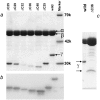Neither helix in the coiled coil region of the axle of F1-ATPase plays a significant role in torque production
- PMID: 18708468
- PMCID: PMC2576389
- DOI: 10.1529/biophysj.108.140061
Neither helix in the coiled coil region of the axle of F1-ATPase plays a significant role in torque production
Abstract
F(1)-ATPase is an ATP-driven rotary molecular motor in which the central gamma-subunit rotates inside the cylinder made of alpha(3)beta(3) subunits. The amino and carboxy termini of the gamma-subunit form the axle, an alpha-helical coiled coil that deeply penetrates the stator cylinder. We previously truncated the axle step by step, starting with the longer carboxy terminus and then cutting both termini at the same levels, resulting in a slower yet considerably powerful rotation. Here we examine the role of each helix by truncating only the carboxy terminus by 25-40 amino-acid residues. Longer truncation impaired the stability of the motor complex severely: 40 deletions failed to yield rotating the complex. Up to 36 deletions, however, the mutants produced an apparent torque at nearly half of the wild-type torque, independent of truncation length. Time-averaged rotary speeds were low because of load-dependent stumbling at 120 degrees intervals, even with saturating ATP. Comparison with our previous work indicates that half the normal torque is produced at the orifice of the stator. The very tip of the carboxy terminus adds the other half, whereas neither helix in the middle of the axle contributes much to torque generation and the rapid progress of catalysis. None of the residues of the entire axle played a specific decisive role in rotation.
Figures






Similar articles
-
Axle-less F1-ATPase rotates in the correct direction.Science. 2008 Feb 15;319(5865):955-8. doi: 10.1126/science.1151343. Science. 2008. PMID: 18276891
-
Torque generation in F1-ATPase devoid of the entire amino-terminal helix of the rotor that fills half of the stator orifice.Biophys J. 2011 Jul 6;101(1):188-95. doi: 10.1016/j.bpj.2011.05.008. Biophys J. 2011. PMID: 21723829 Free PMC article.
-
None of the rotor residues of F1-ATPase are essential for torque generation.Biophys J. 2014 May 20;106(10):2166-74. doi: 10.1016/j.bpj.2014.04.013. Biophys J. 2014. PMID: 24853745 Free PMC article.
-
Torque, chemistry and efficiency in molecular motors: a study of the rotary-chemical coupling in F1-ATPase.Q Rev Biophys. 2015 Nov;48(4):395-403. doi: 10.1017/S0033583515000050. Q Rev Biophys. 2015. PMID: 26537397 Free PMC article. Review.
-
A rotary molecular motor that can work at near 100% efficiency.Philos Trans R Soc Lond B Biol Sci. 2000 Apr 29;355(1396):473-89. doi: 10.1098/rstb.2000.0589. Philos Trans R Soc Lond B Biol Sci. 2000. PMID: 10836501 Free PMC article. Review.
Cited by
-
Deciphering Intrinsic Inter-subunit Couplings that Lead to Sequential Hydrolysis of F1-ATPase Ring.Biophys J. 2017 Oct 3;113(7):1440-1453. doi: 10.1016/j.bpj.2017.08.015. Biophys J. 2017. PMID: 28978438 Free PMC article.
-
The molecular structure of an axle-less F1-ATPase.bioRxiv [Preprint]. 2024 Aug 9:2024.08.08.607276. doi: 10.1101/2024.08.08.607276. bioRxiv. 2024. Update in: Biochim Biophys Acta Bioenerg. 2025 Jan 1;1866(1):149521. doi: 10.1016/j.bbabio.2024.149521. PMID: 39149353 Free PMC article. Updated. Preprint.
-
Elastic coupling power stroke mechanism of the F1-ATPase molecular motor.Proc Natl Acad Sci U S A. 2018 May 29;115(22):5750-5755. doi: 10.1073/pnas.1803147115. Epub 2018 May 14. Proc Natl Acad Sci U S A. 2018. PMID: 29760063 Free PMC article.
-
Bacterial F-type ATP synthases follow a well-choreographed assembly pathway.Nat Commun. 2022 Mar 8;13(1):1218. doi: 10.1038/s41467-022-28828-1. Nat Commun. 2022. PMID: 35260553 Free PMC article.
-
Cryo-EM structure of the homohexameric T3SS ATPase-central stalk complex reveals rotary ATPase-like asymmetry.Nat Commun. 2019 Feb 7;10(1):626. doi: 10.1038/s41467-019-08477-7. Nat Commun. 2019. PMID: 30733444 Free PMC article.
References
-
- Kagawa, Y., and E. Racker. 1966. Partial resolution of the enzymes catalyzing oxidative phosphorylation. IX. Reconstruction of oligomycin-sensitive adenosine triphosphatase. J. Biol. Chem. 241:2467–2474. - PubMed
-
- Catteral, W. A., and P. L. Pedersen. 1971. Adenosine triphosphatase from rat liver mitochondria. I. Purification, homogeneity, and physical properties. J. Biol. Chem. 246:4987–4994. - PubMed
-
- Yoshida, M., E. Muneyuki, and T. Hisabori. 2001. ATP synthase—a marvelous rotary engine of the cell. Nat. Rev. Mol. Cell Biol. 2:669–677. - PubMed
-
- Boyer, P. D., and W. E. Kohlbrenner. 1981. The present status of the binding-change mechanism and its relation to ATP formation by chloroplasts. In Energy Coupling in Photosynthesis. B. R. Selman and S. Selman-Reimer, editors. Elsevier, Amsterdam, The Netherlands. 231–240.
Publication types
MeSH terms
Substances
LinkOut - more resources
Full Text Sources

